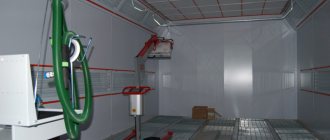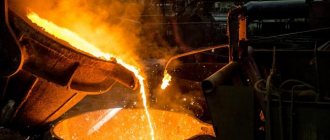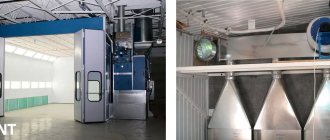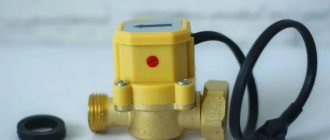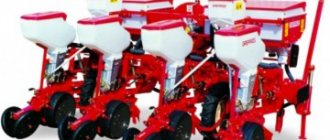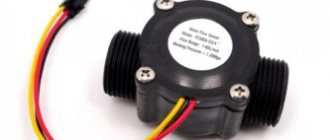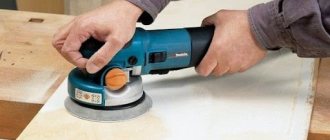General information about centrifugal radial fans
Coil fans have a dual designation (marking): VR and VC, that is, radial and centrifugal.
The first indicates that the blades of the working part of the equipment are located radially relative to their rotor. The second is the designation of the physical principle of operation of the device, that is, the process of intake and movement of air masses occurs due to centrifugal force. It is centrifugal fans in ventilation systems that have shown themselves on the positive side due to the high efficiency of air removal.
Operating principle
As already mentioned, fans of this modification operate based on the action of centrifugal force.
- The blades attached to the rotor of the device rotate at high speed, creating turbulence inside the housing.
- The inlet pressure drops, which causes the suction of nearby air, which rushes inward.
- Under the action of the blades, it is thrown to the periphery of the space, where high pressure is created.
- Under its action, the air flow rushes to the outlet pipe.
This is how all centrifugal models work, which are installed not only in ventilation systems, but also in smoke removal systems. About the latter, it must be said that their body is made of aluminum alloy or steel, coated with heat-resistant materials, and is equipped with an explosion-proof electric motor.
Design Features
As already mentioned, the main design feature is the snail. It is also necessary to indicate the shape of the blades. Fans of this brand use three types:
- with straight slope,
- with a backward tilt
- in the form of a wing.
The first position is small fans with high power and performance. That is, they can create conditions in which other models require a large body. At the same time, they operate with low noise levels. The second position is an economical option that consumes 20% less electricity than other positions. Such fans can easily withstand loads.
As for the design that relates to the electric motor, there are also three positions:
- the rotor is fixed directly to the motor shaft through a coupling and bearings;
- through a belt drive using pulleys;
- The impeller is mounted on the electric motor shaft.
And one more feature is the connection points between the fan and the air ducts of the ventilation system. The inlet pipe has a rectangular hole shape, the outlet is round.
Tywent WBN 130/1 – for small spaces
Centrifugal (radial) drum-type fan. The working body is enclosed in a steel casing, made in the shape of a snail. High-strength steel was used to make the wheel and blades. An additional protective coating is a polymer applied using the polyester method and heated in an oven.
The power device is a single-phase synchronous electric motor 220 volts. Used to work together with a general ventilation system. The mount is stationary.
Pros:
- Small in size, efficient, easy to install.
- The use of steel for the body and blade drum plus a polymer protective coating.
- Acceptable cost with appropriate build quality and technical characteristics.
Minuses:
- It’s impossible to stand nearby for a long time; your head begins to buzz from the noise.
Recommendations: 10 Best Ceiling Fans
15 Best Fans for Home
9 best bathroom fans
What is a centrifugal fan
A centrifugal fan is used as a duct fan. To make things easier, the vacuum cleaner contains what looks like a duct fan. Now think:
- The dust is sucked up by a hose.
- Passes into the bag (tank, compartment).
- Passes filtration.
- The engine passes.
- It is ejected from the back of the case.
What it does is that there is a centrifugal fan inside, formed by a drum (squirrel cage) mounted on the motor shaft. This is not enough. The engine with the impeller is enclosed in a sealed housing, through the channels of which the air escapes to the outside. Without a tight casing, the meaning of the centrifugal fan will be lost. Here's the main difference. Unlike axial fans, which often serve for personal needs, centrifugal fans are used in the economic sphere: room ventilation, cleaning, air purification. To understand how to make a centrifugal fan, let's study the principle of operation of the device.
Characteristics for selecting a centrifugal fan
The table below shows the calculated ratio of air volume to duct diameter and pressure loss per meter of duct.
An example of the mistakes made is presented in more detail, using a specific example, in the article Typical mistakes when selecting equipment.
Conclusion: when choosing a fan, not only the static pressure of the fan or, in other words, the performance of the fan is taken into account. The static air pressure created by the fan should be taken into account when choosing air ducts, where the choice of air duct is significantly influenced by the volume of air we need to move.
Characteristics of centrifugal fans VENTS
How to buy a “Snail” fan
Selecting a centrifugal fan
When choosing a radial fan, you should pay attention to:
- characteristics - performance, pressure, electric motor power, supply voltage;
- installation and overall dimensions, diameter of nozzles, design of connections with air ducts;
- purpose - for work in normal or aggressive environments;
- Availability of automation, performance control and protection equipment.
The price of “Snail” fans depends on the manufacturer, size and purpose. For work in a normal environment, a general-purpose unit that is inexpensive is suitable. If the atmosphere contains corrosive gases, you will have to buy a special purpose fan at a higher price.
Fan selection
Axial ceiling, wall and duct fans are able to clean sanitary rooms of any size from unpleasant odors and humidity. Before choosing a fan for bathroom ventilation, you need to know the parameters by which they need to be selected. So, let’s look at the example of popular models that meet all sanitary and hygienic requirements.
Fan model for a large ventilation duct
For example, overhead wall/ceiling fans Vents 100 Quiet. They are installed directly in the ventilation duct - the diameter of the devices is 100 and 125 mm. It is possible to install it in a flexible air duct using a clamp. Some models are fastened with screws, others do not have fastenings. The body is made of high-strength, waterproof plastic. The blades are aerodynamic. All components subject to vibration during operation are made of rubber, which reduces the noise level. The engine is on ball bearings. There is a timer - from 2 to 30 minutes. Productivity – 100 cubic meters/hour. The same parameters are available for axial fans, which can be mounted both in the wall and on the ceiling, MEROX W 100 BN and Electrolux E AF-100.
Axial duct fans are used for installation in an air duct. For a clear example, consider a ventilation fan for a private house or apartment Soler&Palan TD-Silent. It has a reduced noise level. To facilitate installation and maintenance, the device is equipped with mounting brackets. In addition, the presence of such devices allows you to mount it not only on a horizontal surface, but also on a wall. Quick release clamps have rubber seals. The terminal box rotates 360°. The Vents TT 100 duct fan has similar parameters.
The main parameter for choosing a fan is its performance. The required indicator is easy to calculate, knowing the area, ceiling height and air exchange rate of the room. Multiplying these values will give you the required fan power.
Snail hood
Perhaps the most common design for an exhaust ventilation unit in industrial workshops is a snail hood. Its design differs significantly from centrifugal fans.
This model is characterized by ease of manufacture and installation in the workshop. Its main element is the frame on which the electric motor is mounted. A round fan box is mounted to the engine mounting flanges. A centrifugal fan in a sound-insulated casing, connected to the electric motor shaft, is placed through a central hole in the box inside. Due to the special angle of installation of the blades on the fan air duct wheel, when it rotates, a vacuum is created in the cavity behind it. This ensures a constant flow of air to the exhaust unit and its movement further in the outlet pipeline.
The number of blades, their sizes and sealing at the points of contact between low and high pressure determines the flow rate. The wheel diameter can vary from 25 to 150 cm, depending on the volume of pumped air.
Snail hoods are divided into three classes:
- Low pressure (P-100 kg/m²). They are used, as a rule, in domestic conditions and small workshops.
- Medium pressure (P-from 100 to 300 kg/m²). The devices are used in production workshops with low gas contamination.
- High pressure (P- more than 300 kg/m²). They are used in particularly polluted places, be it paint shops or areas of metallurgical plants with a high concentration of harmful substances.
Depending on the environment with which the blades will come into contact, they are made heat- and corrosion-resistant.
Supercharger sizes
The dimensions of snail fans vary significantly. You can choose a snail for an air conditioning system in a private home, or purchase powerful, productive industrial units. Hood sizes vary from 250 to 1500 mm. Depending on the dimensions and intended use, the fan can be manufactured as a single product or have a modular design with main components that can be easily replaced. The latter option allows you to modernize the equipment used at minimal cost.
Main characteristics of centrifugal fans
The main characteristics of any cooler, including centrifugal ones, include:
- Pressure indicator;
- Volumetric air use;
- The frequency at which the blades rotate;
- Device efficiency;
- Sound pressure level.
Nowadays, most manufacturers of ventilation equipment have in their assortment centrifugal mechanisms with an outlet that fits channels with round cross-sections. Their diameter ranges from 100 to 400 millimeters. They also produce air ducts with a rectangular cross-section with dimensions ranging from 300x150 millimeters to 1000x500 millimeters. Thus, the expansion of the model range made it possible to use these designs not only in domestic, but also in industrial ventilation systems.
Installation and connection of the exhaust fan
During the repair process or after it, before installation, it is necessary to consider the electrical connection system of the device.
The wires can be stretched before laying the tiles inside the channel or run them outside through a fan. Before installation, it is necessary to turn off the power to the house or apartment to avoid electric shock. Then carry out the following steps:
- Remove the back panel of the device and pull the wires through it.
- Secure the wires to the terminals of the device. White - attached to the clamp marked L, and blue - white (zero) - to N.
- Attach the front part of the fan and check its operation.
- If the device works properly, proceed to its installation.
What to consider when purchasing an exhaust fan
its following characteristics
Performance. Any buyer can calculate this parameter, even without special knowledge. All you need to do for this is to multiply the volume of the room by the air exchange rate. The last parameter refers to the number of air changes per 1 hour of operation. In this case, the multiplicity depends on the type of room for which the exhaust device is purchased. So, for a bathroom used by up to 3 people, it will be equal to 6, if there are more than 3 users - 8 and up to 10 for a toilet.
When choosing a silent fan model for an extractor hood, it is advisable to buy a device that has inflated performance. So, for a bathroom, a device with an indicator of 95-100 m3/h is best suited.
The level of noise created during operation of the device. The operation of a fan is inevitably accompanied by noise - mechanical and aerodynamic. Under the first there is noise that arises as a result of the operation of the engine, or, more precisely, vibration transmitted to the air duct. Aerodynamic is the noise that arises from the movement of air currents. To prevent a duct fan from creating inconvenience for you, choose models with noise levels of no more than 25 dB. Models with a threshold of more than 35 dB will not allow you to stay indoors for a long time without feeling discomfort. Therefore, it is not recommended to purchase devices with similar characteristics for residential premises.
There is a solution to reduce the noise level of a duct fan. This can be done by installing a muffler behind the housing, as well as by additionally finishing the ventilation shaft with a material that has enhanced sound insulation characteristics.
Design safety. This parameter indicates the level of protection of the device from moisture and dust. It is necessary to take this into account if you are looking for a duct fan model that you are going to install in a rectangular shaft in the bathroom or kitchen, where high humidity is constantly present. If moisture gets inside the housing, a short circuit may occur. Therefore, it makes sense to immediately buy fans equipped with moisture protection for such rooms. As an alternative, you can purchase devices that can operate in low voltage 24V conditions.
Hood functionality. Today in stores you can find 100 mm models that can operate in two modes - automatic or standard. Standard axial supply fans start working the moment the lights in the room are turned on. This is an excellent solution for rooms where the humidity level is normal. If the humidity in the room is constantly increased, then it will be difficult for such devices to remove air. In this case, it is best to purchase a model with a timer that will automatically turn the device on and off.
Also, some fan models can be equipped with a special humidity sensor, which is very convenient for the bathroom. Of course, such hood devices will cost more than standard ones. But thanks to the use of such additions in them, they will be able to remove excess moisture from the room much better and faster.
Quality of the device. If you want a bathroom or toilet fan to serve you for many years without requiring attention to operation and repair, then choose models that meet international standards. For example, make sure that the duct fan has a protection class of at least IP 34.
Don't skimp on buying a fan for your home. Try to purchase models that are produced by well-known companies and are very popular among consumers.
How to make it yourself
One of the features of such snails is their different price range. The minimum price for a snail hood will be about 3 thousand, but such devices, as a rule, are not very powerful and are very limited in size. The average price of a high-quality unit will exceed 20 thousand rubles.
Therefore, for domestic needs, it is more advisable to make a homemade snail for extractor hood. The standard design of such a housing will consist of two parts: the engine will be located in one zone, and the blowing blades in the other .
The casing for the snail can be purchased at hardware stores. If you are going to make it yourself, purchase the motor and other parts in advance, since the dimensions will have to be adjusted. It is better to make the case from metals (for example, aluminum and steel). Plastic will be less resistant to mechanical damage, and wood will quickly catch fire in the event of a malfunction.
The fan in such a system will operate at high speed. Therefore, incorrect design of the hood can have bad consequences. Check the quality and reliability of not only the base itself and fastening mechanisms, but also the motor, impeller and fan.
The fan dimensions are selected taking into account the area and degree of contamination of the room. Industrial designs are large.
Important! When installing the motor inside the box of such a hood, make sure that the design includes cooling holes. High temperature stress on the system can lead to an explosion.
Pay special attention to the choice of internal materials. Fan operation can be affected not only by temperature, but also by the power of air flow, the amount of debris and dust.
When air with large impurities is sucked in, the blades of the rotating wheel may be damaged. And in order to thoroughly clean the air, the unit must operate at high speed and under high pressure - this creates additional stress on the entire internal structure. Therefore, it is better to choose parts made of durable materials, such as steel or aluminum .
Compliance with the following recommendations will allow you to create a high-quality and safe hood with a long service life:
- choose the right size and power of the motor : take into account the maximum load on the structure, as well as the required operating speed of the hood;
- When mounting such a system vertically, carefully check the reliability of the fan and wheel fastening : with rapid air flows, they can jump off or change their location;
- materials adjacent to such a hood must be fireproof , as are all parts used in its assembly;
- observe the proportions between the individual hood zones : in the standard models offered in stores, the optimal ratio of the length and width of the structure is taken into account;
- If you are not sure that the assembled hood is safe, contact specialists who will check its serviceability .
Please note that hoods are rarely used in living rooms . Firstly, they take up a lot of space, and secondly, in rooms like a kitchen, the flow of polluted air can have different directions, so it is best to install such a hood in a ventilation shaft, where all the air coming from the apartment is concentrated.
The design of such structures will also play an important role in living rooms, but it is not diverse and does not always harmonize with the interior.
Tip: When placing such a hood in an open environment (outdoors), make sure that weather conditions will not affect its functionality.
Ventilation hoods can be used not only for air purification . In domestic conditions, they will do an excellent job of heating the room, and will also affect the humidity in the room .
The cost of equipment intended for domestic and industrial needs will differ significantly, but, in any case, such units have sufficient power for full operation.
For an example of designing a snail hood, see the attached video.
Centrifugal fan design
The design of a centrifugal fan is quite simple. A wheel with blades is located in a housing with inlet and outlet openings. An electric motor is used to operate the device.
The unit works on the following principle: the blades rotate and thereby ensure air movement. Air is sucked in through the inlet under the influence of centrifugal force and pushed out through the outlet.
The direction of movement of air masses at the outlet is perpendicular to the incoming flow. Due to the fact that high pressure is created inside, such fans can move large amounts of air.
This feature allows the use of centrifugal devices in main channels of complex design and long length. Such fans are easy to use and, if used correctly, last for quite a long time.
Rotating blades can be installed perpendicular or parallel to the axis of the circle. With a parallel arrangement, the noise during operation of the device is reduced, but the efficiency does not decrease.
Devices of the second type have less power and small dimensions. Both options are in demand among consumers, but differ in their scope of application.
During production, centrifugal fans are equipped with additional functions to perform specific tasks. For example, for use in a room with high temperatures, the device must be equipped with special thermal protection.
If you intend to use it in conditions of high humidity, then the device must have increased resistance to corrosion. Some models even provide explosion protection.
These functions can be combined in one unit, but more often models have one of them.
When selecting a centrifugal model, you must be guided by two important parameters:
- the volume of air masses that pass through the outlet in a certain period of time;
- air pressure at the fan outlet.
Knowing these indicators will help you make the right choice.
Features of operation and maintenance
The radial type installation has only two structural parts . This feature makes it resistant to external loads and able to work for a very long time without the need for repair or restoration work. The only serious problem for the equipment may be vibration . Therefore, it is important to ensure high-quality installation with vibration dampers, elastic gaskets on flange connections and other protective elements.
In addition, when using installations outdoors, you should organize a reliable site with a canopy that protects from precipitation and dust. This will make it possible to reduce wear on rotating parts and extend their service life.
There is practically no specific service as such. The usual procedures are carried out - cleaning from contaminants, replacing grease on bearings and other standard actions. Some devices work for years in hard-to-reach places without any maintenance at all, without losing their functionality.
Types of device
Today, many different versions of fan units are produced. Each is designed for specific operating conditions, which are different everywhere, so there are no universal solutions in this area.
Centrifugal fans are divided according to the direction of rotation:
- right (clockwise) rotation;
- left (counterclockwise).
Fans are also divided according to the type of drive mechanisms:
- belt;
- straight;
- adjustable.
Fans are divided according to pressure level and the following types are distinguished:
- high (3 kPa - 12 kPa);
- medium (1 kPa - 3 kPa);
- low (up to 1 kPa) pressure.
According to the direction of air flow, fan installations are classified as follows:
- exhaust;
- and double-sided suction.
There are also installations for use in aggressive environments, and most of these units are highly specialized and are intended only for operation in one specific environment, for example, a chlorine environment. Installations for it are made from materials that are resistant to chlorine, and if such a unit is used to work in a different aggressive environment, then it is far from certain that it will maintain the tightness of the working chamber and will not fail.
Conventional fans are designed for operation at gas temperatures up to 80 degrees, and the content of solid impurities in it is no more than 100 mg per cubic meter. There are also installations for use in dusty environments, the so-called. dust fans in which the content of solid impurities in the working fluid is limited to one kilogram per m³. Also worthy of mention are explosion-proof rotary fans with a pneumatic drive, used in mine ventilation and other explosive enterprises.
There are also significant differences in drives; the simplest and most reliable of them is direct. In it, the impeller is installed directly on the engine shaft, there is practically nothing to break. This drive still has a drawback - the need to have a speed controller for the motor when it is necessary to regulate the power of the fan unit, since the design of the drive does not allow changing the speed of rotation of the impeller without changing the engine speed.
https://youtube.com/watch?v=HxXsOBi-K80
Next comes the belt drive, its reliability is lower than that of the direct drive (the belt can jump off the pulley or break), but it is already possible to change the rotor speed without changing that of the engine. It consists of two pulleys (the first is on the motor shaft, the second is on the same shaft with the impeller), having several grooves with different diameters, by throwing the belt between them, you can change the gear ratio, thereby changing the fan speed without affecting the engine.
The last type of drive, the most modern of all, is adjustable. In it, rotational motion is transmitted through a magnetic or hydraulic coupling located between the motor and fan shafts. Since such a drive is technically more complex than all previous ones, for ease of control it uses a microcontroller, which makes it possible to use fans with such a drive in centralized systems where a remote control function is implemented.
As for the difference between double-suction and exhaust fan installations, it is obvious: in the exhaust fan, gas is taken from one end, and in the first, from both ends.
Electric motors used
The industrial snail hood is equipped with explosion-proof electric motors, durable housings and covers. Most often, asynchronous mechanisms with a fixed rotation speed are used as a drive. This unit quickly reaches maximum performance and is reliable and durable. The disadvantages of asynchronous electric motors include the inability to adjust the speed of rotation of the working shaft, which somewhat limits the possibilities of using such equipment.
The presence of dimming in the electric motor and an automatic control unit allows you to regulate the rotation speed, significantly expanding the functionality of the use of volute fans. The disadvantage of using such motors with variable speed control is their high cost, as well as reduced reliability of units in which the electronics that control the operation of the drive often fail.
Rules for installing a fan yourself
Installation of the exhaust fan is quite simple. To do this, you need tools and materials such as: an angle grinder, a hammer drill, self-tapping screws, indicator and regular screwdrivers, a terminal connector, and an electrical cable.
In case of independent connection of the device, it is necessary to lay a line from the junction box to the fan switch, and then to the device itself. If there are features in the connection diagram of the selected model, they are always indicated in the instructions.
Self-installation of the fan
The step-by-step installation of the fan is as follows:
- Measuring the diameter of the device pipe and ventilation duct. Maximum fit to size will ensure effective operation of the device.
- Laying power lines to the fan and connecting it.
- Removing the ventilation grille and installing the fan into the duct opening using the recommended materials: glue, fasteners.
- Installing the mesh and grille, securing it with self-tapping screws or silicone.
- Checking the fan's functionality.
When connecting the fan yourself, follow the electrical safety rules. Be sure to turn off the power when running lines from the appliance to the breaker. Use only terminal blocks to connect wires, it is convenient and safe.
Video:
Video:
Fans for extracting air masses are distinguished by design.
They have a cylindrical shape; a blade ventilation system is mounted inside the cavity, driven by an electric motor. With this design solution, the air passes along the axis of the device. A manifold is installed at the inlet, which is necessary to improve the aerodynamics of the entire device. Among the advantages of this type of exhaust device, the efficiency should be highlighted - over 100 m³ per hour of operation.
Plus, the exhaust fan is characterized by simple installation, so it is often installed in the fan. openings of kitchens and bathrooms. The only disadvantages include high noise level of about 30-50 dB and low pressure.
Radial exhaust fan
They have a “spiral” type housing, inside of which a wheel is placed. When this wheel rotates, the air masses move in the radial direction, the mass is compressed under the influence of centrifugal forces and is removed from the housing.
The blades of the device are directed both forward and in the opposite direction; in the first case, the savings will be up to 20% of electricity. Plus, the noise of the device will decrease significantly. Blades curved forward increase power. Radial modifications of ventilation systems are characterized by their small dimensions, ease of installation and versatility.
Centrifugal exhaust fan
appeared on the market quite recently, the model has already gained enormous popularity among the user community. Centrifugal force fans for exhaust are excellent for installation in rooms with an area of more than 15 m²; they have good power characteristics and almost silent operation. The advantage of centrifugal systems is that it can be installed both in front of the air intake and in the middle of the shaft.
Engineers have also developed specialized units for forced smoke removal with an explosion-proof function. Axial smoke removal systems are designed to send out air masses that are full of harmful and explosive impurities.
An explosion-proof axial type fan is necessary, first of all, to organize forced exhaust of air masses containing explosive impurities. The use of such devices in everyday life is extremely rare, but in woodworking and other industries where there is a risk of explosion and fire, they are ubiquitous.
Exhaust fan with check valve
Recommended equipment and prices
Low pressure radial (centrifugal) fans BP 80-75 (BP 86-77) priced from 9,494 rubles .
- -20%
Low pressure radial fans VR 80-75 (VR 86-77)VR 80-75 No. 10 11 kW 750 rpm
out of 5
223 600 ₽ 178 880 ₽Select options Add to wishlist
- -20%
Low pressure radial fans VR 80-75 (VR 86-77)
VR 80-75 No. 10 15 kW 1000 rpm
out of 5
227 600 ₽ 182 000 ₽Select options Add to wishlist
- -20%
Low pressure radial fans VR 80-75 (VR 86-77)
VR 80-75 No. 10 18.5 kW 1000 rpm
out of 5
255 800 ₽ 204 640 ₽Select options Add to wishlist
- -20%
Low pressure radial fans VR 80-75 (VR 86-77)
VR 80-75 No. 10 22 kW 1000 rpm
out of 5
288 000 ₽ 230 400 ₽Select options Add to wishlist
Centrifugal fans VENTS
The Vents plant relatively recently began producing centrifugal fans. The main and so far significant drawback is the cost of the “snail”, but in contrast to the price, a warranty service has been established that works conveniently. All transportation and repair costs are borne by the manufacturer. Fans have a huge selection of models based on performance and air flow pressure. Equipped with a well-balanced impeller, there is virtually no vibration. They have small sizes and modest weight. Which is generally convenient when installing ventilation equipment. The main difference is warranty and post-warranty service.
Conclusion: each manufacturer has its own pros and cons, knowing this, you can make the right choice.
New items
{youtube}YdsgmER9bmA{/youtube}
Advantages and disadvantages
The ventilation volute combines reliable design and excellent efficiency. The advantages of this type of equipment include:
- affordable price;
- ease of operation, maintenance and repair;
- reliability and wear resistance;
- performance.
Disadvantages include difficulties in adjusting power and rotation speed. Such operating features are typical for fans equipped with an asynchronous motor. If it is necessary to change the rotation speed, it is necessary to purchase units with advanced automatic control, which leads to an increase in the cost of the equipment.
Comparative characteristics of axial and centrifugal fans
If you compare the operating parameters of the units, you can identify the following differences.
The main advantage of axial models is their high efficiency. If necessary, for example, quickly removing air from a room, it will do an excellent job. It moves air at high speed with blades around the rotor axis.
The blades and air in such a fan move in the same direction and plane. At the same time, it is not capable of creating high pressure, so it is often used as an independent device, without air ducts.
Axial fans are distinguished by their compact size, simplicity of design and ease of installation. Thanks to their simple design, in the event of a breakdown, it will not be difficult to repair them.
In radial models, on the contrary, the direction of the air does not coincide: at the outlet the air flow is perpendicular to the incoming one.
A radial fan creates significantly higher pressure than an axial fan. But at the same time their productivity is slightly less. Such devices are capable of moving air masses along a long path over long distances.
They can be installed in difficult sections of air ducts to maintain a certain level of pressure in the network. These characteristics of radial fans make them indispensable for industrial use.
Such structures can both pump air and suck it in, so their scope of application is very wide. For example, they are successfully used in production for smoke and dust removal.
Kinds
Types of centrifugal fans of snails are three positions, differing from each other in power. This parameter depends on the rotation speed of the electric motor, and therefore the rotor, as well as on the number of blades in the device design. Here are three types:
- Low pressure volute fans, the parameter of which does not exceed 100 kg/cm². Most often they are used in ventilation systems of apartment buildings. Install snails on roofs.
- Medium pressure models – 100-300 kg/cm². Installed in ventilation systems of industrial facilities.
- High pressure variety – 300-1200 kg/cm². These are powerful fan units, which are usually included in the air exhaust system of paint shops, in industries where pneumatic transport is installed, in warehouses with fuels and lubricants and other premises.
There is another division of snail fans - according to their purpose. These are primarily general purpose devices. Then there are three more positions: explosion-proof, heat-resistant and corrosion-resistant.


